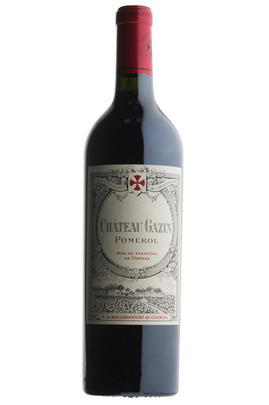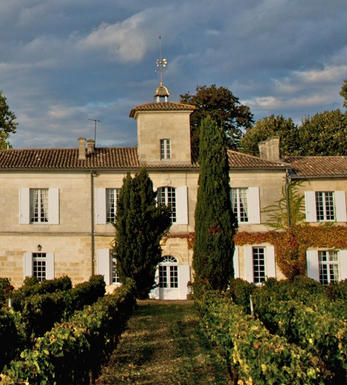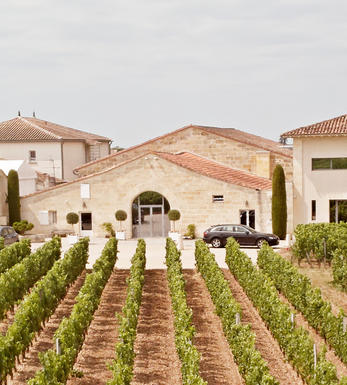
2010 Château Gazin, Pomerol, Bordeaux

Critics reviews
The 2010 Gazin has a delightful bouquet with more red than black fruit (raspberry, cranberry and a touch of red cherry) - a joyful and perhaps less “serious” nose, but one with detail and class. The palate is medium-bodied with fine-grain tannins. This feels very lithe with an almost perfect bead of acidity. Harmonious and extremely long, this is a brilliant Pomerol from Nicolas de Bailliencourt and it will age with supreme class. Outstanding.
Drink 2020 - 2050
Neal Martin, Vinous.com (April 2020)
Deep garnet in color, the 2010 Gazin charges out of the gate with bold boysenberries, baked plums and Christmas cake notes plus hints of unsmoked cigars and bouquet garni. Full-bodied, the palate is jam-packed with baked black fruit, framed by firm, ambitious tannins, finishing long and mineral tinged.
Drink 2020 - 2046
Lisa Perrotti-Brown, Wine Advocate (March 2020)
Looks relatively mature. Sweet, evolved nose. Tastes years ahead of most of its peers in terms of development so the tannins are much less obvious. Positively satin-textured in fact! Lots of fun even if not for the extremely long term. Very attractive long finish.
Drink 2017 - 2036
Jancis Robinson MW, JancisRobinson.com (February 2020)
A subtle red with ultra-fine tannins that accentuate a palate of chocolate, berries and nuts. Full and very round. It's refined and beautiful. Hard not to drink now but wait at least five years. Top wine from Gazin.
James Suckling, JamesSuckling.com (February 2013)
Wow! This wine exceeded my enthusiastic barrel tasting notes. A big, back-strapping blockbuster from Gazin, in which the oak seems to be pushed into the background (thankfully), the wine offers up notes of caramelized black cherry and black currant fruit interwoven with mocha, white chocolate, subtle toast and hints of coffee beans and tobacco leaf. The exceptional aromatics are easily followed up by a full-bodied, powerful, broodingly backward, rich, intense wine with multiple dimensions, layers of fruit, and a sensational finish of close to a minute. This is one of the all-time great efforts from Gazin. It should be forgotten for 6-10 years and drunk over the following 30 to 40.
Drink 2019 - 2059
Robert M. Parker, Jr., Wine Advocate (February 2013)
The kind of vintage that was always going to suit Gazin, and for certain there is plenty of the estate signature here - dark fruits, bitter chocolate, firm tannins and architectural angles. Excellent persistency, this stretches out through the palate. Impressive rather than loveable perhaps, but there is depth and concentration and it is just about starting to open up, underscoring as ever that Gazin is among the last of the Pomerols to reach its drinking window.
Drink 2020 - 2045
Jane Anson, Decanter.com (January 2020)
About this WINE

Château Gazin
Château Gazin was reputedly built upon the ruins of the Hôpital de Pomeyrols which was originally established by the Knights of Malta in the 12th century. It has been owned by the Bailliencourts dit Courcol, one of France's oldest families, since the beginning of the last century.
Gazin is located in the eastern part of the Pomerol plateau, where the soils are rich in clay and limestone. Gazin's 26-hectare vineyard (large by Pomerol standards) adjoins the vineyards of L'Evangile and Petrus. The wine is a blend of Merlot (80%), Cabernet Franc (15%) and Cabernet Sauvignon (5%). The grapes are vinified traditionally and the wine is matured in oak barriques (50% new) for 15-18 months.

Pomerol
Pomerol is the smallest of Bordeaux's major appellations, with about 150 producers and approximately 740 hectares of vineyards. It is home to many bijou domaines, many of which produce little more than 1,000 cases per annum.
Both the topography and architecture of the region is unremarkable, but the style of the wines is most individual. The finest vineyards are planted on a seam of rich clay which extends across the gently-elevated plateau of Pomerol, which runs from the north-eastern boundary of St Emilion. On the sides of the plateau, the soil becomes sandier and the wines lighter.
There is one satellite region to the immediate north, Lalande-de-Pomerol whose wines are stylistically very similar, if sometimes lacking the finesse of its neighbour. There has never been a classification of Pomerol wines.
Recommended Châteaux : Ch. Pétrus, Vieux Ch. Certan, Le Pin, Ch. L’Eglise-Clinet, Ch. La Conseillante, Ch. L’Evangile, Ch. Lafleur, Trotanoy, Ch. Nenin, Ch. Beauregard, Ch. Feytit-Clinet, Le Gay.

Cabernet Sauvignon Blend
Cabernet Sauvignon lends itself particularly well in blends with Merlot. This is actually the archetypal Bordeaux blend, though in different proportions in the sub-regions and sometimes topped up with Cabernet Franc, Malbec, and Petit Verdot.
In the Médoc and Graves the percentage of Cabernet Sauvignon in the blend can range from 95% (Mouton-Rothschild) to as low as 40%. It is particularly suited to the dry, warm, free- draining, gravel-rich soils and is responsible for the redolent cassis characteristics as well as the depth of colour, tannic structure and pronounced acidity of Médoc wines. However 100% Cabernet Sauvignon wines can be slightly hollow-tasting in the middle palate and Merlot with its generous, fleshy fruit flavours acts as a perfect foil by filling in this cavity.
In St-Emilion and Pomerol, the blends are Merlot dominated as Cabernet Sauvignon can struggle to ripen there - when it is included, it adds structure and body to the wine. Sassicaia is the most famous Bordeaux blend in Italy and has spawned many imitations, whereby the blend is now firmly established in the New World and particularly in California and Australia.


Buying options
Add to wishlist
Description
The 2010 Gazin has a delightful bouquet with more red than black fruit (raspberry, cranberry and a touch of red cherry) - a joyful and perhaps less “serious” nose, but one with detail and class. The palate is medium-bodied with fine-grain tannins. This feels very lithe with an almost perfect bead of acidity. Harmonious and extremely long, this is a brilliant Pomerol from Nicolas de Bailliencourt and it will age with supreme class. Outstanding.
Drink 2020 - 2050
Neal Martin, Vinous.com (April 2020)
wine at a glance
Delivery and quality guarantee